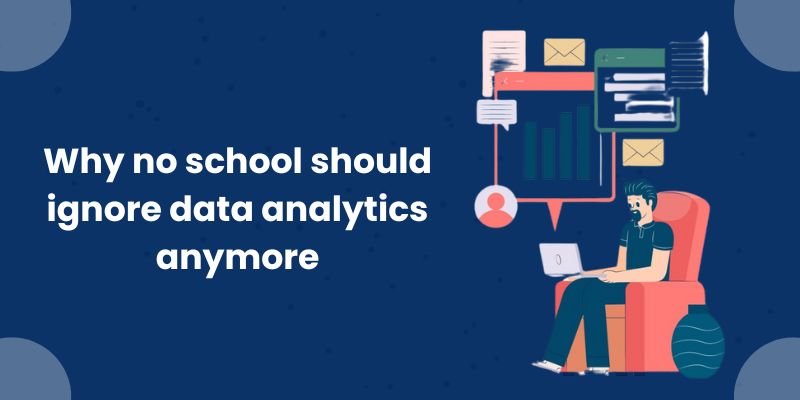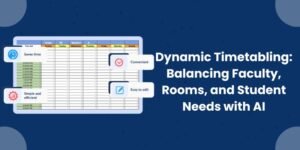In today’s digital world, data is more than just numbers on a spreadsheet—it is insight, foresight, and opportunity. While industries like healthcare, finance, and retail have long embraced data analytics to drive results, educational institutions are only now beginning to harness its full potential. Schools that ignore data analytics risk falling behind, not just in efficiency but in delivering meaningful educational outcomes.
This isn’t just about keeping up with trends. It’s about making smarter, fairer, and more informed decisions—for students, staff, and the entire institution.
The Changing Role of School Administration
Traditionally, school leadership focused on intuition, experience, and manual processes to make decisions. While valuable, this approach is no longer sufficient in an age of growing student populations, complex academic programs, rising parental expectations, and stringent compliance standards.
Modern school leaders must handle:
- Diverse student needs and learning gaps
- Resource planning and allocation
- Performance tracking and academic forecasting
- Admission trends and outreach analysis
- Infrastructure and financial management
These areas generate vast volumes of data, often siloed or underutilized. That’s where data analytics—powered by school ERP systems—becomes a transformative tool.
What Is Data Analytics in Education?
Data analytics in education refers to the collection, processing, and analysis of academic and administrative data to uncover trends, patterns, and actionable insights. These insights help decision-makers understand what’s working, what’s not, and how to improve outcomes.
From attendance rates and exam scores to teacher performance and fee collection, everything can be monitored and optimised. The result? A proactive, rather than reactive, approach to education management.
Why Data Analytics Matters More Than Ever
1. Personalised Student Learning Paths
Every student learns differently. Some thrive in group discussions, others prefer visual aids. Some grasp concepts quickly, while others need more time and repetition. With data analytics, teachers and administrators can identify individual learning patterns through real-time data.
For example, if a student is consistently underperforming in math but doing well in language and science, early intervention can be planned. Teachers can modify their instruction methods, and counselors can step in before the issue worsens.
This isn’t possible with generic grading or periodic assessments alone. Data analytics enables truly personalised education pathways.
2. Better Teacher and Staff Evaluation
Analytics also support objective staff evaluations. Instead of relying on isolated feedback or end-of-year reviews, administrators can use performance data drawn from classroom outcomes, student engagement metrics, and learning outcomes over time.
Teachers themselves benefit from seeing trends—where students consistently struggle, how different teaching methods impact understanding, and where they can improve their practice. This results in a stronger professional development culture grounded in evidence.
3. Efficient Resource Allocation
School budgets are always under pressure. Whether it’s lab equipment, library books, or staff hiring, every rupee must be spent wisely.
With data analytics, schools can monitor how resources are being used and make informed decisions. For instance, if certain classrooms or labs are underutilized, scheduling can be adjusted. If digital content is used more in higher classes, investment in those resources can be scaled accordingly.
Optimising resource allocation is essential for long-term institutional sustainability.
4. Predictive Insights for Planning
One of the most powerful aspects of data analytics is its ability to offer predictive insights. Schools can forecast admission trends, student dropouts, exam pass rates, and infrastructure needs. With predictive analytics built into a robust school ERP system, decision-makers no longer have to guess—they can plan with confidence.
For example, if data shows a rising number of students opting for a particular elective or extracurricular, schools can prepare additional faculty or facilities in advance. Predictive data also helps institutions maintain compliance and accreditation with less hassle.
5. Streamlined Communication with Parents
Parents want transparency, but flooding them with raw data can lead to confusion. Instead, ERP systems equipped with analytics tools can deliver digestible insights through dashboards or mobile apps.
These insights can include:
- Learning progress over time
- Homework completion trends
- Subject-wise performance
- Attendance patterns
When parents are kept informed with clear, data-backed insights, it builds trust and strengthens the parent-school partnership.
Barriers to Adoption—and How to Overcome Them
Despite the clear benefits, some schools hesitate to adopt analytics-driven systems. Common concerns include lack of technical expertise, fears around data privacy, and the upfront cost of implementation.
The good news? Modern education ERP platforms are built with user-friendliness, compliance, and scalability in mind. Here’s how schools can overcome adoption challenges:
- Start Small: Begin with academic performance tracking or attendance data before expanding to other areas.
- Choose the Right ERP: Look for platforms that offer intuitive dashboards, flexible modules, and secure cloud storage.
- Train Staff: Ensure that teachers and administrators are trained not just to enter data, but to read and interpret it.
- Prioritise Privacy: Work with ERP providers who comply with national and international data protection norms.
With the right approach, even smaller or rural schools can leverage analytics to create a big impact.
Real-World Impact: A Snapshot
Let’s consider a mid-sized school that implemented data analytics through their ERP system. Within one year:
- Student dropout rates fell by 30% due to timely interventions.
- Average math scores improved by 15% thanks to early identification of weak learners.
- The school reduced its operational costs by 10% through better inventory and timetable management.
- Parent satisfaction rose, with a 40% increase in engagement on the school’s parent app.
These numbers aren’t theoretical—they reflect what’s possible when schools embrace data-driven education management.
The Future of Smart Schools
In a few years, data analytics will no longer be a “nice-to-have.” It will be as essential as textbooks or classrooms. Schools that act now will build resilience, adaptability, and excellence into their systems—qualities that will matter even more in an increasingly competitive and fast-changing world.
The goal is not to replace human intuition with algorithms but to enhance it with evidence. When data and empathy work together, education becomes more inclusive, more equitable, and more effective.
Data analytics is not about collecting information for the sake of it. It’s about turning that information into meaningful action. In a school setting, that could mean helping a student reach their potential, supporting a teacher’s growth, or ensuring smooth operations that let the focus stay on learning.
By investing in school analytics tools and embracing a data-driven education management approach, educational institutions position themselves for long-term success. It’s time to stop asking “Can we afford to adopt data analytics?”and start asking “Can we afford not to?”












